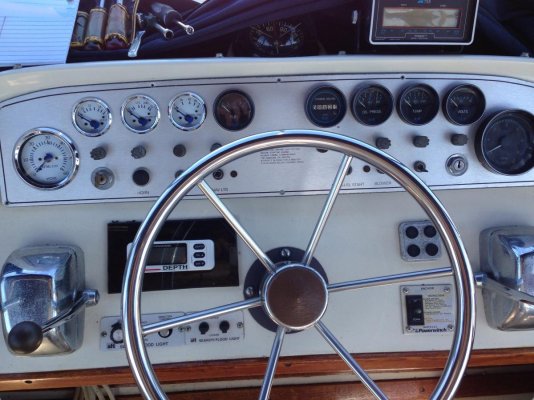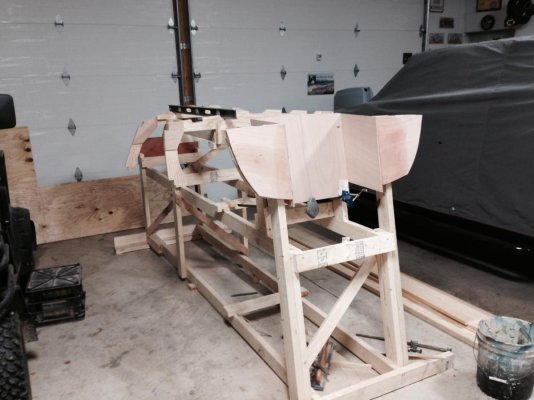Never really occurred to me, what I had done until describing the boat to a friend that is huge fan of trawlers.
Had been (probably accurately) describing it as a semi-displacement hull but once running it realizing how slow the damn thing is ( ), a light bulb went off and it all made sense
), a light bulb went off and it all made sense 
Boat is an '87 36' DC w/twin 270 HP, 350 cu in Crusaders and 6.5 KW Kohler generator.
Have owned it 2 months now and had it away from dock last weekend for the first time since the sea trial.
Loved it!
We were shopping at the bottom end of the budget for aft cabins and most we found in that range stopped being boats 3-4 yrs ago and became cottages.
As did this one.
As in, interior was gorgeous but nothing mechanical functioned
Luckily, I've done this all my life and am able to do most of the chores myself.
Sold an '86 Marinette 32' sedan/bridge (2nd 32', third Marinette) that was perfect to buy this project, knowing we'd spend most of the end of this season at dock (as in, a cottage) while I sorted it.
Top of list is motors. Starboard was recently rebuilt but port is orig.
On sea trial both motors ran warmer than I like so I replaced t.stats (160*) and topped off antifreeze (closed cooling) before going out last weekend.
At idle in neutral I saw approx 180* (new gauges) which is where it stayed under load up to approx 2800 - 3000 RPM.
Anything above that they climbed to 200* (which I don't like) and stayed there.
Based on feel and spray off the hull, I suspect the difference between 2800 - 3200 will only be felt at the fuel dock.
Overall I will say though, I am way impressed with this boat. The fit and finish, attention to detail, glass work is equal w/almost anything I've seen.
And i used to build vacuum infused 28' sport fish boats for the most anal guy I've ever met.
I am particularly impressed (as a glass guy) w/the glass piece that surrounds the ceiling of the main salon. Has built in wire chases, cavities for curtain tracks (full length of cabin!) and the gauge/dash panel for the lower helm and finished in gel coat.
This is all one piece w/not a single straight line anywhere. Would have taken hundreds of hours to get the mold right.
The picture is while anchored off the campground at Kellies Island in Lake Erie Ohio and the short video is coming around the west side of the island and passing the West Bay Inn. Has free dockage to enjoy lunch and a beverage and to see some of the best sun sets in the world.
Our wives were nice enough to give my brother (boat shopping again for first time in 20 yrs) and I hall passes for the weekend to play on the boat.
Anyhow, thanks for letting me play and I thought you guys might like to follow along w/the project.
Gary
Had been (probably accurately) describing it as a semi-displacement hull but once running it realizing how slow the damn thing is (
Boat is an '87 36' DC w/twin 270 HP, 350 cu in Crusaders and 6.5 KW Kohler generator.
Have owned it 2 months now and had it away from dock last weekend for the first time since the sea trial.
Loved it!
We were shopping at the bottom end of the budget for aft cabins and most we found in that range stopped being boats 3-4 yrs ago and became cottages.
As did this one.
As in, interior was gorgeous but nothing mechanical functioned

Luckily, I've done this all my life and am able to do most of the chores myself.
Sold an '86 Marinette 32' sedan/bridge (2nd 32', third Marinette) that was perfect to buy this project, knowing we'd spend most of the end of this season at dock (as in, a cottage) while I sorted it.
Top of list is motors. Starboard was recently rebuilt but port is orig.
On sea trial both motors ran warmer than I like so I replaced t.stats (160*) and topped off antifreeze (closed cooling) before going out last weekend.
At idle in neutral I saw approx 180* (new gauges) which is where it stayed under load up to approx 2800 - 3000 RPM.
Anything above that they climbed to 200* (which I don't like) and stayed there.
Based on feel and spray off the hull, I suspect the difference between 2800 - 3200 will only be felt at the fuel dock.
Overall I will say though, I am way impressed with this boat. The fit and finish, attention to detail, glass work is equal w/almost anything I've seen.
And i used to build vacuum infused 28' sport fish boats for the most anal guy I've ever met.
I am particularly impressed (as a glass guy) w/the glass piece that surrounds the ceiling of the main salon. Has built in wire chases, cavities for curtain tracks (full length of cabin!) and the gauge/dash panel for the lower helm and finished in gel coat.
This is all one piece w/not a single straight line anywhere. Would have taken hundreds of hours to get the mold right.
The picture is while anchored off the campground at Kellies Island in Lake Erie Ohio and the short video is coming around the west side of the island and passing the West Bay Inn. Has free dockage to enjoy lunch and a beverage and to see some of the best sun sets in the world.
Our wives were nice enough to give my brother (boat shopping again for first time in 20 yrs) and I hall passes for the weekend to play on the boat.
Anyhow, thanks for letting me play and I thought you guys might like to follow along w/the project.
Gary





